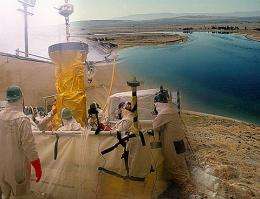Research shows that the concentration of carbonate and the pH of the groundwater can slow uranium’s progress toward waterways.
(PhysOrg.com) -- Uranium's migration through the soil depends on groundwater's chemical composition, according to a recent study by Pacific Northwest National Laboratory. Scientists showed that uraniumattached to soil particles and moved slowly when the groundwater was at neutral pH and contained low levels of carbonate ion or dissolved carbon dioxide. Such conditions often occur at riverbanks when the river water rises and mixes with the groundwater. This work appeared in the September 1 issue of Environmental Science & Technology.
To control uranium's fate and transport, scientists must understand how fast uranium attaches to and releases from soil particles under different chemical conditions. For example, at a former plutonium production site in southeastern Washington State, uranium-contaminated groundwater is moving toward the nearby Columbia River. Using the results of experiments and a mathematical model, scientists are learning how the river's changing levels slow uranium's movement.
The scientists began with uranium-contaminated sediment from an Integrated Field Research Challenge Site. This site is located on the southern tip of the Hanford Site, a former plutonium production site near the Columbia River in southeastern Washington State.
Then, they conducted experiments where they exposed the sediment to solutions with different pH, calcium, and carbonate levels. In these experiments, the sediment and solutions were constantly stirred.
The researchers found that uranium's detachment from the sediment was slowed when the groundwater's pH and carbonate concentration were decreased. The result implied that uranium release from the sediment will be slow where groundwater is diluted by river water with low levels of carbonate and at neutral pH, and will be much quicker at inland regions where groundwater contains high levels of carbonate and is more basic.
Next, the researchers used the experimental data to evaluate a mathematical model to describe the uranium absorption and desorption under variable groundwater chemical conditions. The model is designed based on the most advanced knowledge available. While the model provided a good description of the experimental results, discrepancies between the model and the experimental data exist.
Research is on-going to understand the fundamental theories behind the observed dependence of uranium adsorption and desorption on groundwater's chemical composition. These theories will help improve or re-design the mathematical model.
More information: Liu C, Z Shi, and JM Zachara. 2009. "Kinetics of Uranium(VI) Desorption from Contaminated Sediments: Effect of Geochemical Conditions and Model Evaluation." Environmental Science & Technology 43(17):6560-6566. pubs.acs.org/journal/esthag
Provided by PNNL





















